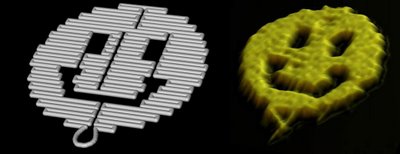DNA Origami
PASADENA, Calif.--In a new development in nanotechnology, a researcher at the California Institute of Technology has devised a way of weaving DNA strands into any desired two-dimensional shape or figure, which he calls "DNA origami."
"The construction of custom DNA origami is so simple that the method should make it much easier for scientists from diverse fields to create and study the complex nanostructures they might want," Paul Rothemund, a senior research fellow, explains.
Reporting in the March 16th issue of Nature, Rothemund describes how long single strands of DNA can be folded back and forth, tracing a mazelike path, to form a scaffold that fills up the outline of any desired shape.

Each of the short DNA strands can act something like a pixel in a computer image, resulting in a shape that can bear a complex pattern, such as words or images. The resulting shapes and patterns are each about 100 nanometers in diameter-or about a thousand times smaller than the diameter of a human hair.
Although Rothemund has hitherto worked on two-dimensional shapes and structures, he says that 3-D assemblies should be no problem. In fact, researchers at other institutions are already using his method to attempt the building of 3-D cages.
Caltech Press Release, 3/15/2006, Dr. Paul Rothemund, Dr. Erik Winfree


0 Comments:
Post a Comment
<< Home